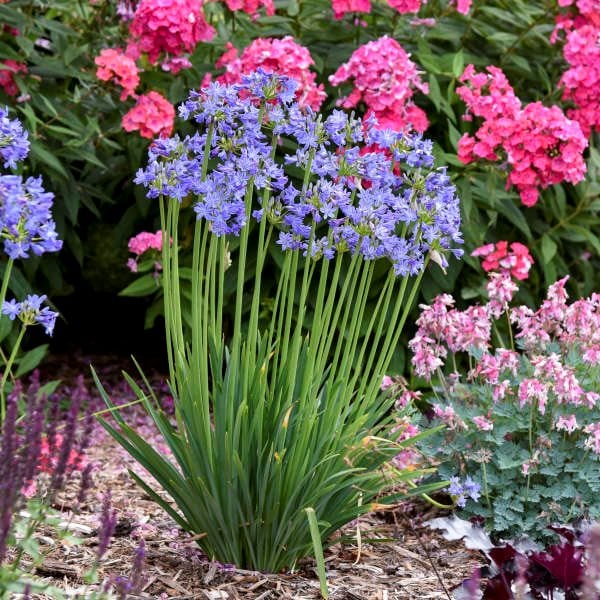Mastering the Art of Agapanthus Treatment: Crucial Steps for Healthy Growth and Vivid Blooms
In the world of horticulture, the cultivation of agapanthus stands as a satisfying undertaking for those that look for to support these elegant blooming plants. With their striking flowers and elegant foliage, agapanthus has actually caught the focus of gardeners worldwide. Nonetheless, accomplishing optimum development and dynamic blooms needs a nuanced method that encompasses different essential steps. From choosing the best selection to understanding pruning methods, the trip in the direction of growing growing agapanthus plants is complex and holds the vital to opening the complete capacity of these organic gems.

Picking the Right Agapanthus Range

When selecting the best Agapanthus selection for your garden, take into consideration factors such as environment suitability, flower shade, and growth routine. Agapanthus, generally referred to as Lily of the Nile or African lily, is available in a variety of shades varying from tones of purple and blue to white. Choose a blossom color that enhances your existing garden combination to develop an unified landscape. Furthermore, consider the climate in your region to make certain the Agapanthus range you pick can flourish in your particular conditions. Some selections are more tolerant of cold temperature levels, while others like warmer climates. Understanding the growth habit of various Agapanthus selections is vital for proper positioning within your garden. Some selections have a clumping growth habit, perfect for borders or containers, while others have an even more dispersing nature, ideal for ground cover or mass plantings. By very carefully reviewing these variables, you can pick the excellent Agapanthus selection to enhance the beauty of your garden.
Suitable Planting Problems
Thinking about the optimum environmental requirements is crucial for effective Agapanthus cultivation. Agapanthus plants are delicate to chilly temperatures and should be safeguarded from frost throughout winter season months.
To make sure healthy development and vibrant blooms, plant Agapanthus light bulbs at a depth of concerning 2-4 inches and room them 8-12 inches apart. Mulching around the base of the plants aids preserve wetness and reduces weed development.
Watering and Feeding Tips
Keeping proper dampness levels and giving crucial nutrients are crucial elements in the treatment program for Agapanthus plants. It is crucial to strike an equilibrium when it comes to watering Agapanthus. These plants choose regularly moist dirt yet are vulnerable to root rot if overwatered. Throughout the growing period, water deeply when a week, ensuring the soil is well-draining view it to protect wikipedia reference against waterlogging. In hotter environments or during durations of drought, more frequent watering might be needed to maintain the soil evenly damp. Nevertheless, reduce watering in the winter season to protect against water logged conditions.
Fertilizing Agapanthus is essential for advertising healthy growth and prolific flowers. Use a well balanced fertilizer, such as a 10-10-10 formula, in the early springtime as new development arises. Repeat this application every 6-8 weeks throughout the growing period. Prevent too much fertilization, as it can cause lush foliage at the expenditure of blooms. Always follow the supplier's guidelines for appropriate dilution and application methods. By following these watering and feeding tips, you can ensure your Agapanthus plants flourish and generate lively, long-lasting blossoms.
Trimming Techniques for Agapanthus
Pruning Agapanthus plants at the ideal times and with correct strategies is important for keeping their wellness and promoting optimum growth and flowering. The optimal time to prune Agapanthus is in late wintertime or very early springtime before brand-new growth emerges. Start by eliminating any dead or yellowing leaves near the base of the plant. Cut them as short as possible without harming the arising shoots.
Deadheading spent flowers can additionally redirect the plant's power right into producing more flowers rather than establishing seeds. If you want to collect seeds for proliferation, leave some flowers to dry and fully grown on the plant.
Remember to make use of tidy, sharp tools to make exact cuts and reduce the risk of presenting diseases. Agapanthus. Regular pruning will aid keep your Agapanthus looking healthy and cool while guaranteeing a bountiful display screen of lovely blooms
Managing Typical Pests and Diseases
After ensuring proper pruning methods for Agapanthus, it is vital to resolve usual bugs and illness that can impact my explanation the health and vigor of these plants. Agapanthus plants are generally sturdy but can still come down with particular issues. One common pest that affects Agapanthus is the Agapanthus gall midget. This little, orange fly lays its eggs in the foliage, leading to distorted development and blossom buds that stop working to open. To combat this insect, trim and damage any kind of afflicted plant components and take into consideration using insecticidal soap.
Additionally, Agapanthus plants can suffer from root rot if they are planted in improperly draining dirt. By being watchful and taking timely action against parasites and illness, you can help your Agapanthus plants thrive and create lively blossoms. Agapanthus.

Final Thought
In conclusion, mastering the art of agapanthus care involves selecting the right variety, supplying optimal growing problems, proper watering and feeding, suitable pruning techniques, and dealing with common insects and illness. By following these essential actions, you can ensure healthy and balanced development and vivid blooms for your agapanthus plants. Keep in mind to consistently monitor and keep your plants to promote their total wellness and longevity.
To ensure healthy development and vibrant blossoms, plant Agapanthus bulbs at a deepness of about 2-4 inches and area them 8-12 inches apart. By following these watering and fertilizing pointers, you can guarantee your Agapanthus plants thrive and create lively, durable flowers.
One usual pest that influences Agapanthus is the Agapanthus gall midget. In addition, Agapanthus plants can endure from origin rot if they are planted in poorly draining pipes dirt. By adhering to these necessary steps, you can guarantee healthy and balanced development and vibrant blooms for your agapanthus plants.